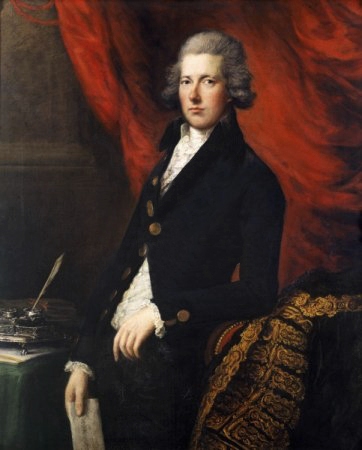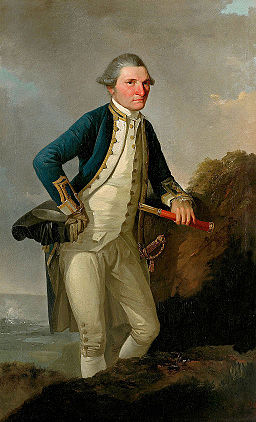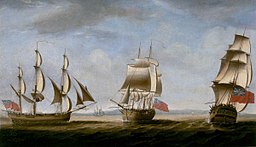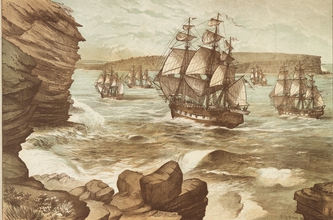First Fleet Convicts to Australia
Approximately 50,000 convicts were sent to North America up until the end of the American War of Independence in 1783, but from this point on they refused to accept any more convicts. Around this time machinery was also becoming more popular, therefore labourers and farm workers were being put out of work and driven towards the cities. This in turn led to increased crime rates and eventually overcrowded prisons, therefore William Pitt, the British Prime Minister at the time, decided that Australia would be the answer to his problems.
Australia was first contacted by the Europeans just 17 years earlier when the British explorer, James Cook, was attempting to examine the planet Venus in order to determine the distance from the Earth to the Sun.
The First Fleet departed from Portsmouth, a city located on the south coast of England, on May 13, 1787 and sailed for around 250 days. The fleet was comprised of eleven ships - six prison ships, three equipment ships, and two navy ships, Sirius and Supply. After an extremely long journey, the First Fleet finally arrived at Botany Bay, located in Sydney, New South Wales, between January 18 and 20, 1788.
Soon after, they moved to the more sheltered harbour at Port Jackson, which fleet leader, Captain (later Admiral) Arthur Phillip (1738-1814), renamed Sydney Cove. This was the first European colony in New South Wales and marked the beginning of convict transportation to Australia.
Over a span of 81 years (1787-1868), an estimated 160,000 convicts were sent from Britain to Australia. Theft, larceny, and burglary were the most common crimes and about 28,000 people received a life sentence. Of the 160,000 people sent, 81.8% were male and 18.8% were female. Many of the convicts worked as labourers and a large number of them were prosecuted in Middlesex, London, Lancaster, Surrey, and Warwick. Smith, Jones, William, Brown, and Johnson were the five most common surnames among the convicts, and interestingly there were 603 men recorded with the name John Smith.
The Eleven Ships of the First Fleet
| Ship | Captain/Master | Purpose |
| H.M.S. Sirius | Captain John Hunter | Escort |
| H.M.S. Supply | Captain Arthur Phillip | Escort |
| Alexander | Master Duncan Sinclair | Convict transport |
| Charlotte | Master Thomas Gilbert | Convict transport |
| Friendship | Master Francis Walton | Convict transport |
| Lady Penrhyn | Master William Server | Convict transport |
| Prince of Wales | Master John Manson | Convict transport |
| Scarborough | Captain John Marshall | Convict transport |
| Borrowdale | Master William Sharp | Storeship |
| Fishburn | Master Robert Brown | Storeship |
| Golden Grove | Master Houston Reed | Storeship |
Notable First Fleet members
- Augustus Alt, surveyor
- Richard Johnson, chaplain
- Arthur Phillip, governor
- Philip Gidley King, 2nd lieutenant, later lieutenant governor of Norfolk Island, and 3rd governor of the colony
- John Hunter, captain of H.M.S. Sirius, later 2nd governor of the colony
- Henry Lidgbird Ball, captain of H.M.S. Supply
- John White, principal surgeon
- Thomas Arndell, assistant surgeon, later settler
- William Balmain, assistant surgeon, later principal surgeon
- Arthur Bowes Smyth, assistant surgeon, author of journal
- Dennis Considen, assistant surgeon
- Thomas Jamison, surgeon's mate
- Henry Brewer, clerk to Phillip, provost marshall, administrator
- Quartermaster Henry Hacking, settler, explorer
- Major Robert Ross, commander, later lieutenant governor of Norfolk Island
- 2nd Lieutenant Ralph Clark, author of journal
- Captain David Collins, judge advocate, later commandant of first settlement at Hobart
- Lieutenant William Dawes, engineer, surveyor, humanitarian
- Lieutenant George Johnston, later commander of NSW Corps
- Captain Watkin Tench, author of journal
- Lieutenant William Bradley, author of journal, water colourist
- Mary Braund and William Bryant, escapees from colony
- John Baughan, carpenter, mill owner, attacked by NSW Corps
See Also
Sources
- ^ "File:William Pitt the Younger 2.jpg." Wikimedia Commons, the free media repository. 1 May 2019, 17:03 UTC. https://commons.wikimedia.org/w/index.php?title=File:William_Pitt_the_Younger_2.jpg&oldid=348206027
- ^ "File:John Webber - Portrait of Captain James Cook - Google Art Project.jpg." Wikimedia Commons, the free media repository. 17 Jun 2019, 18:43 UTC. https://commons.wikimedia.org/w/index.php?title=File:John_Webber_-_Portrait_of_Captain_James_Cook_-_Google_Art_Project.jpg&oldid=355136365
- ^ "File:First Fleet stores ship Borrowdale.jpg." Wikimedia Commons, the free media repository. 16 Jan 2018, 01:34 UTC. https://commons.wikimedia.org/w/index.php?title=File:First_Fleet_stores_ship_Borrowdale.jpg&oldid=279969772
- ^ "File:The First Fleet entering Port Jackson, January 26, 1788, drawn 1888 A9333001h(cropped).jpg." Wikimedia Commons, the free media repository. 28 Oct 2018, 15:46 UTC. https://commons.wikimedia.org/w/index.php?title=File:The_First_Fleet_entering_Port_Jackson,_January_26,_1788,_drawn_1888_A9333001h(cropped).jpg&oldid=325737825
- ^ Davison, Grame (ed.) et al, The Oxford Companion To Australian History, Oxford University Press, 1998
- ^ Gillen, Mollie, The Founders of Australia: a biographical dictionary of the First Fleet, Sydney, Library of Australian History, 1989
- ^ Bateson, Charles, The Convict Ships, 1787-1868, Sydney, 1974
- ^ Hughes, Robert, The Fatal Shore, London, Pan, 1988



